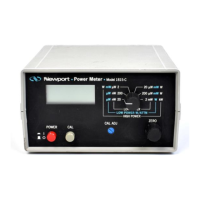10
Section 3
Principles of Operation
The Model 1815-C is an optical power meter whose electronics can adapt to
the signals from both semiconductor and themopile detectors. This versatility
is required to handle the various signals that Newport’s Low-Power, and High-
Power detector families generate. These detector families are based on
semiconductor and disk thermopile detectors respectively.
A block diagram of signal flow through the Model 1815-C is shown in Figure 6.
The actual flow through the diagram depends upon the SETUP switch settings.
Calibration
Adjust
A/D
Converter
Digital
Display
Output
Amplifier
Output
BNC
Input
BNC
Configurable
Amplifier
ZERO
Adjust
Signal
Accelerator
Figure 6 — Simplified Model 1815-C Functional Block Diagram
The Model 1815-C Optical Power Meter is a configurable current or voltage
measuring instrument optimized for use with semiconductor photodiodes
(current measurement) or disk thermopiles (voltage measurement).
Detector signals are introduced to the Model 1815-C by way of a BNC input
connector. A bank of DIP switches found on the back of the Model 1815-C
configures the amplifier as either a transimpedance current amplifier or as a
1 MΩ input impedance voltage amplifier. The amplified signal is then further
processed via a ZERO offset adjust, a Calibration Factor compensation (adjust-
able signal attenuator) stage, and if appropriate a signal accelerator circuit.
The resulting signal is then sent to the A-D converter and displayed.
This section describes detector and attenuator characteristics, optical and
electrical considerations, and environmental influences on optical measure-
ments. In general, the accuracy of measurement with the Model 1815-C is
limited by the calibration accuracy of the detector calibration. Making accu-
rate measurements of optical power is however, also dependent upon prop-
erly setting up the Model 1815-C, controlling temperature and illumination
conditions and understanding the factors that affect power measurement.
Introduction
3.1
Functional
Description
3.2
Measurement
Considerations
3.3

